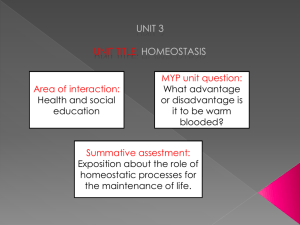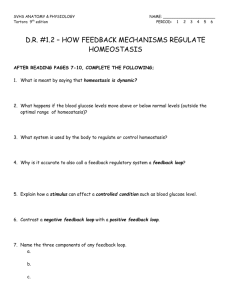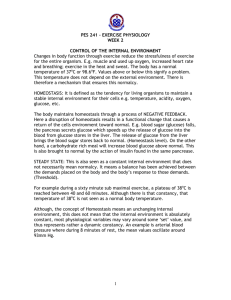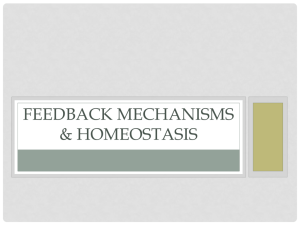Homeostasis
advertisement
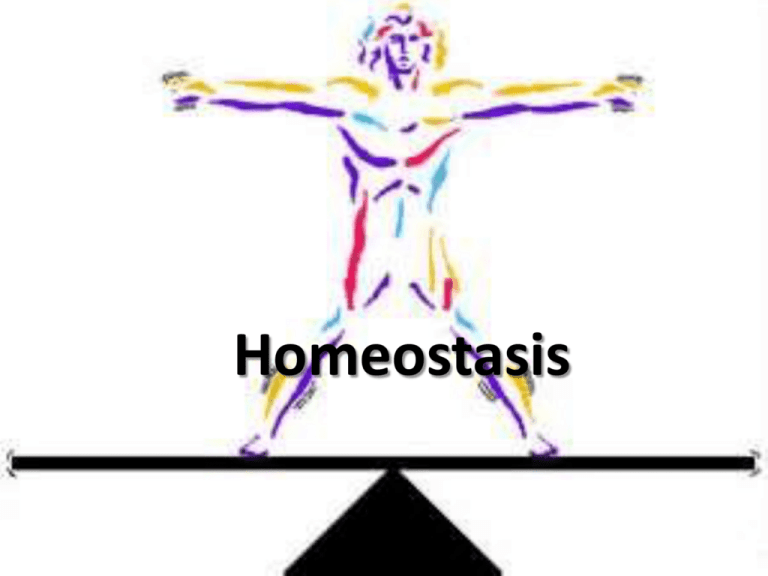
Homeostasis Objectives 1) Discuss the importance of homeostasis 2) Explore how negative feedback systems work 3) Work through specific feedback systems used to maintain blood glucose and body temperature It Is All About Balance… • All living things must react to their environment to survive – Homeostasis regulated stable state; constantly adjusting • Unicellular direct contact with world • Multicellular ??? – Most internal cells do not have direct contact – ECF (extracellular fluid) • Plasma • Tissue fluid Types of Adjustment • What are the two ways an organism can change? 1) Regulators adjust to resist environment and maintain a stable state – Warm-blooded animals (thermo regulators) 2) Conformers adjust to match environment to maintain their stable state – Cold-blooded animals (thermo conformers) • Either method, what things must be regulated in all living things? – Concentration of nutrients, O2, CO2, waste, water, NaCl, pH, and plasma – Temperature Types of Homeostasis • Complex organisms require multiple levels of homeostasis to stay alive • Cells maintain this own homeostasis but must work together in a complex organism 1) Local homeostatic controls organs/tissue adjusting to demands – Stomach maintains pH low enough to work but not low enough to hurt stomach 2) Systemic homeostatic controls organs regulate other organs – Hypothalamus (part of brain) Feedback Systems: Key to Homeostasis • Negative feedback keep homeostasis regulated most of the time 1) Stimulus environmental change 2) Receptor senses stimulus (input) 3) Integrator compares information from sensor to set point (normal level) 4) Effector response from integrator (output) Example: It is cold in this room 1) Stimulus cold 2) Receptor temp. sensor in heater (18oC) 3) Integrator computer compares temp. sensor to set point temp. (25oC) 4) Effector heater turn on until room is 25oC Homeostasis In Living Things • We are not perfect machines; homeostasis always fluctuates around a set point • What is the average pulse rate of the human heart? – 60 Beats/min • 60 beats is our set point; but you rarely get 60 beats/min – Fluctuate above and below 60; average out to set point Feedback Loops: Blood Glucose • Glucose is major source of energy (respiration) • Regulated by two hormones and negative feedback inhibition • Glucagon promotes breakdown of glycogen to release glucose; happens when hungry or during exercise • Insulin lowers glucose levels in blood after eating by • Diabetes cannot regulate glucose because defective or missing insulin Regulating Blood Glucose 1) You study all morning; running low on energy – Blood glucose is too low!! 2) Hypothalamus tells pancreas to release glucagon; glycogen glucose – Blood glucose back to normal 3) LUNCH TIME!! You eat and digestion breaks starch into glucose – Blood glucose too high!! 4) Hypothalamus tells pancreas to release insulin; liver, muscles, fat tissue absorb glucose – Blood glucose back to normal 5) Repeat all day! Layers of the Skin • What is the job of the skin? – – – – Protect the body Stop pathogens from entering Prevent water loss Detect changes in temp. and pressure – Detect pain – Regulate heat loss • Hair/Fur: – Cold weather hair stand up to help trap air around skin – Hot weather hair lays flat to limit air around ski • Fat layer insulates body against cold Feedback Loop: Body Temp • What is the homeostatic point for body temp? – 37oC • In hot weather: 1) Skin sends info to hypothalamus 2) Vasodilation arteries expand to release heat by radiation 3) Sweat glands salty sweat evaporates from skin which cools you down Feedback Loop: Body Temp (part 2) • In cold weather: 1) Skin sends info to hypythalamus 2) Vasoconstriction arterioles shrink to keep 3) Sweat glands stop producing sweat 4) Shivering muscle contractions burn ATP to generate more heat
